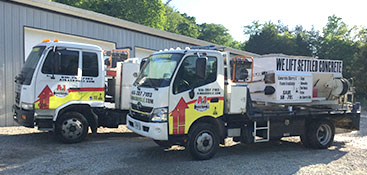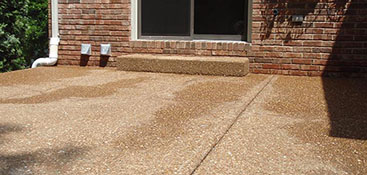Testimonials
How Concrete Is Poured

While you can buy bags of concrete, mix it up your wheelbarrow, and pour it all on your own, concrete pouring is an extensive process! There’s a reason why concrete contractors are in business, and it’s because pouring large concrete slabs like concrete driveways takes a lot of skill.
In today’s blog, we’re giving you a little window into the process of pouring new concrete. While our concrete company primarily performs concrete floor leveling, we are also professionals in concrete pouring for projects like concrete driveways, patios, and basketball courts. Continue reading to learn more and if you’re in need of a concrete professional in Nashville, contact A-1 Concrete Leveling and Foundation Repair.
Preparation
In order for concrete to last as long as possible, the surface must be properly prepared. When homeowners try to pour their own concrete slabs, they often make mistakes in the preparation stage. Expert concrete contractors like A-1 Concrete Leveling and Foundation Repair understand not only how to pour concrete and perform concrete floor leveling, we also know how to fully prepare your surface to prevent problems in the future.
First, the area is clear of any objects or other material that could interfere with the concrete pouring process, like grass, rocks, trees, and old concrete. Everything is cleared away until only the raw earth is exposed. Next, we prepare a subbase to spread over the earth. Subbase can be made from a variety of materials, and a granular fill is the most common form of subbase. In rare cases, the soil itself can be used, if it is extremely stable. Your concrete is only as strong as your subgrade, so if the gravel or soil shifts, the integrity of the concrete is going to be compromised. That’s why it’s very important to tamp down the soil and the subbase before moving forward.
After the surface itself is prepared, the next step is preparing a form. The form is what will hold and secure your concrete as it dries. Most forms are rectangular, though expert concrete contractors like those at A-1 Concrete Leveling and Foundation Repair can create decorative, curving forms, forms with a slight slope, or forms for tight, hard-to-reach areas. A well-built form is vital to pouring concrete with a good finish. A form is usually a wooden perimeter secured by nails or screws.
After the exterior form is created, a wire mesh or rebar is placed inside the form. This mesh gives the concrete its stability, and is essential for things like concrete driveways or roads that will have a lot of wear and tear. Wire mesh also helps guard against cracks growing and spreading.
Mix the Concrete
After the entire area has been properly prepared, it is time to mix the concrete. Concrete can be made from a variety of materials, but a basic formula is one part cement, one part sand, and four parts coarse aggregate like gravel. Water is added to the dry mixture to bind all the ingredients together. Concrete contractors like those at A-1 Concrete Leveling and Foundation Repair use a concrete mixer to ensure that the concrete is at the right consistency and that the materials are fully integrated. When mixing concrete, it’s important to use as little water as possible. While water makes the mixture more maneuverable, it weakens the final product and a drier mix is more crack resistant.
Pour the Concrete
When the concrete is ready, it is poured into the mold that you prepared. Depending on where the concrete slab is being made, the concrete can be poured straight from the truck into the mold. In other, harder to reach locations, a wheelbarrow is necessary. Concrete contractors work as a team to spread out the concrete as it is being poured using shovels and a special concrete rake called a “come along.”
Screed and Float the Concrete
After the concrete has been poured, it is flattened using a screeding tool. Screeding involves jiggling a wide plank across the top of the concrete to create a flat surface. Good screeding is required for a flat, smooth piece of concrete. It’s the point in the process when the surface begins to look more like a finished product.
After screeding, you should move fairly quickly into floating the concrete, as the concrete will set quickly. Floating the concrete involves using a bull float to press down aggregate and help the “cream” or gravel-free concrete rise to the surface. This part of the process can be tricky, and because it’s time sensitive, it’s important to have concrete contractors with their years of expertise pour your concrete.
Create Joints and Traction
After the concrete has been floated, it’s time to make control joints with a grover. These joints help prevent concrete cracks caused by temperature changes. The depth of the joints depends on the thickness of the concrete, and they should be cut about a quarter of the thickness of the concrete.
After the joins have been pressed, you can create simple traction by sweeping a broom across the surface. Doing so helps the concrete be less slippery when wet. Concrete can also be stamped in designs or patterned with a trowel. After the traction has been created, the surface is cured and sealed. It should be sealed as soon as it is poured to prevent cracking and discoloration and then left to cure for 28 days.
A-1 Concrete Leveling and Foundation Repair – Nashville
If you’re thinking about pouring a new concrete driveway or other concrete project, our concrete contractors can help. Along with pouring new concrete, we also specialize in concrete repair like concrete floor leveling and foundation repair. Contact us today for a free quote.
If you found this blog to be useful, check out our other concrete leveling posts:





